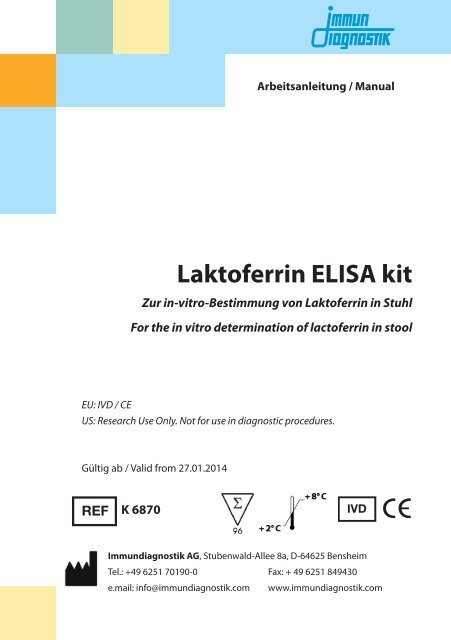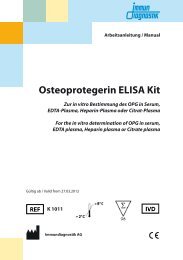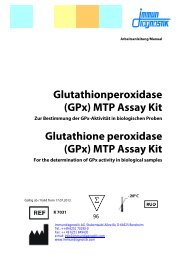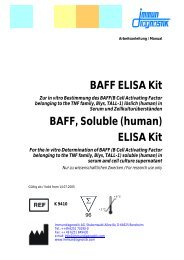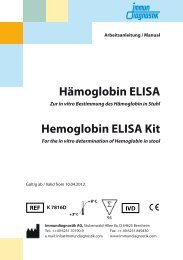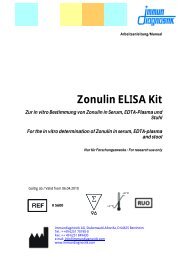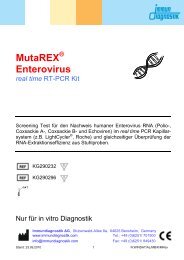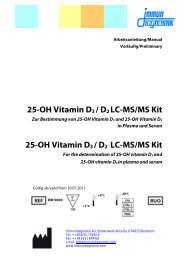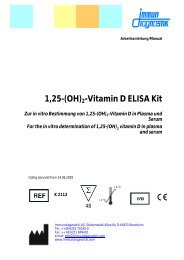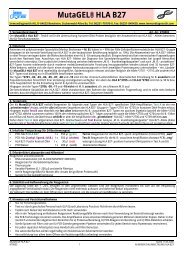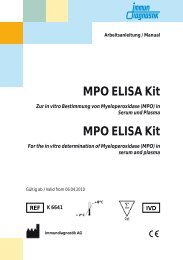Arbeitsanleitung - bei Immundiagnostik
Arbeitsanleitung - bei Immundiagnostik
Arbeitsanleitung - bei Immundiagnostik
Sie wollen auch ein ePaper? Erhöhen Sie die Reichweite Ihrer Titel.
YUMPU macht aus Druck-PDFs automatisch weboptimierte ePaper, die Google liebt.
<strong>Ar<strong>bei</strong>tsanleitung</strong> / Manual<br />
Laktoferrin ELISA kit<br />
Zur in-vitro-Bestimmung von Laktoferrin in Stuhl<br />
For the in vitro determination of lactoferrin in stool<br />
EU: IVD / CE<br />
US: Research Use Only. Not for use in diagnostic procedures.<br />
Gültig ab / Valid from 27.01.2014<br />
K 6870<br />
<strong>Immundiagnostik</strong> AG, Stubenwald-Allee 8a, D-64625 Bensheim<br />
Tel.: +49 6251 70190-0 Fax: + 49 6251 849430<br />
e.mail: info@immundiagnostik.com www.immundiagnostik.com
<strong>Ar<strong>bei</strong>tsanleitung</strong><br />
Laktoferrin<br />
Inhalt<br />
1. VERWENDUNGSZWECK______________________________________________ 2<br />
2. EINLEITUNG________________________________________________________ 2<br />
3. INHALT DER TESTPACKUNG_ _________________________________________ 2<br />
4. ERFORDERLICHE LABORGERÄTE UND HILFSMITTEL____________________ 3<br />
5. VORBEREITUNG UND LAGERUNG DER REAGENZIEN____________________ 3<br />
6. PROBENVORBEREITUNG UND -LAGERUNG_____________________________ 4<br />
Stuhlprobenextraktion_________________________________________________ 4<br />
Probenverdünnung___________________________________________________ 6<br />
7. TESTDURCHFÜHRUNG______________________________________________ 6<br />
Testprinzip_ _________________________________________________________ 6<br />
Pipettierschema_ _____________________________________________________ 6<br />
8. ERGEBNISSE_______________________________________________________ 7<br />
9. EINSCHRÄNKUNGEN_ _______________________________________________ 8<br />
10. QUALITÄTSKONTROLLE______________________________________________ 8<br />
Referenzwerte________________________________________________________ 8<br />
11. TESTCHARAKTERISTIKA_ ____________________________________________ 9<br />
Präzision und Reproduzierbarkeit_________________________________________ 9<br />
Spike-Wiederfindung_ _________________________________________________ 9<br />
Wiederfindung in der Verdünnung_______________________________________ 10<br />
Analytische Sensitivität_______________________________________________ 10<br />
Spezifität__________________________________________________________ 10<br />
12. VORSICHTSMASSNAHMEN _________________________________________ 10<br />
13. TECHNISCHE MERKMALE_ __________________________________________ 11<br />
14. ALLGEMEINE HINWEISE ZUM TEST___________________________________ 11<br />
15. LITERATUR________________________________________________________ 12<br />
1
<strong>Ar<strong>bei</strong>tsanleitung</strong><br />
Laktoferrin<br />
1. VERWENDUNGSZWECK<br />
Der hier beschriebene Assay ist für die Bestimmung von Laktoferrin aus Stuhl geeignet.<br />
Nur zur in-vitro-Diagnostik.<br />
2. EINLEITUNG<br />
Laktoferrin ist ein Eisenbindendes Glykoprotein von 76 kD, welches in den sekundären<br />
Granula von Neutrophilen produziert und gespeichert wird. Zusätzlich ist es<br />
auch in vielen flüssigen Sekreten wie z. B. Milch, Speichel, Tränen und Nasensekret<br />
vorhanden.<br />
Laktoferrin kann in verschiedenen polymeren Formen, von Monomeren bis Tetrameren,<br />
vorliegen; besonders <strong>bei</strong> hohen Konzentrationen neigt es zur Polymerisierung.<br />
Zu den physiologischen Aktivitäten von Laktoferrin zählt die Regulierung der Eisenhomöostase,<br />
unspezifische Abwehr von verschiedenen bakteriellen Infektionen,<br />
anti ent zündliche Wirkung, Regulierung von Zellwachstum und -differenzierung sowie<br />
Schutz vor Krebserkrankungen und Metastasierung.<br />
Bei Darmentzündungen wandern reife Neutrophile in die Darmschleimhaut ein und<br />
setzen Laktoferrin durch Degranulation frei, wodurch die Ausscheidung von Laktoferrin<br />
im Stuhl beträchtlich erhöht wird. Fäkales Laktoferrin ist daher ein Marker der<br />
neutrophilen Darmentzündung.<br />
Indikationen<br />
• Differenzierung zwischen organischer oder funktioneller Darmerkrankung<br />
• Verlaufskontrolle <strong>bei</strong> chronisch entzündlichen Darmerkrankungen (CED)<br />
• Vorhersage eines Rezidivs <strong>bei</strong> CED<br />
• Beurteilung des Therapieerfolgs <strong>bei</strong> CED<br />
3. INHALT DER TESTPACKUNG<br />
Art.-Nr. Bezeichnung Kit-Komponenten Menge<br />
K 6870MTP PLATE Mikrotiterplatte, vorbeschichtet<br />
12 x 8<br />
Vertiefungen<br />
K 6870WP WASHBUF ELISA-Waschpufferkonzentrat 10x 2 x 100 ml<br />
K 6870EP EXBUF Extraktionspufferkonzentrat 2,5x 1 x 100 ml<br />
K 6870K<br />
CONJ<br />
Konjugat (Ziege-anti-humanes-<br />
Laktoferrin)<br />
1 x 200 µl<br />
2
<strong>Ar<strong>bei</strong>tsanleitung</strong><br />
Laktoferrin<br />
Art.-Nr. Bezeichnung Kit-Komponenten Menge<br />
K 6870ST<br />
STD<br />
Standards, lyophilisiert<br />
(0; 7,5; 30; 120; 480 ng/ml)<br />
4 x 5 vials<br />
K 6870KO CTRL Kontrollen 4 x 2 vials<br />
K 6870TMB<br />
K 6870AC<br />
K 6870PV<br />
SUB<br />
STOP<br />
SAMPLEBUF<br />
TMB-Substrat (Tetramethylbenzidin),<br />
gebrauchsfertig<br />
ELISA-Stopplösung,<br />
gebrauchsfertig<br />
Probenverdünnungspuffer,<br />
gebrauchsfertig<br />
1 x 15 ml<br />
1 x 15 ml<br />
1 x 50 ml<br />
4. ERFORDERLICHE LABORGERÄTE UND HILFSMITTEL<br />
• Reinstwasser*<br />
• Laborwaage<br />
• Präzisionspipetten und Pipettenspitzen für den Einmalgebrauch mit variablen<br />
Volumina von 5–1000 µl<br />
• Folie zum Abkleben der Mikrotiterplatte<br />
• Mikrotiterplattenschüttler<br />
• Multikanal- bzw. Multipipette<br />
• Vortex-Mixer<br />
• Zentrifuge, 3000 g<br />
• Laborübliche Glas- oder Plastikröhrchen (Einmalartikel)<br />
• Mikrotiterplattenphotometer<br />
* <strong>Immundiagnostik</strong> AG empfiehlt die Verwendung von Reinstwasser nach ISO 3696. Es handelt<br />
sich da<strong>bei</strong> um Wasser des Typs 1, welches frei von ungelösten und kolloidalen Ionen und<br />
organischen Molekülen ist (frei von Partikeln > 0,2 µm) mit einer elektrischen Leitfähigkeit von<br />
0,055 µS/cm <strong>bei</strong> 25 °C (≥ 18,2 MΩ cm).<br />
5. VORBEREITUNG UND LAGERUNG DER REAGENZIEN<br />
• Bitte achten Sie <strong>bei</strong> mehrfachem Einsatz der Platte darauf, dass die Reagenzien<br />
wie in der Vorschrift beschrieben gelagert und nur die für den jeweiligen<br />
Ansatz benötigten Reagenzienmengen frisch angesetzt werden. Der Kit<br />
kann so bis zu 4 x je nach Probenaufkommen bis zum angegebenen Haltbarkeitsdatum<br />
verwendet werden.<br />
3
<strong>Ar<strong>bei</strong>tsanleitung</strong><br />
Laktoferrin<br />
• Reagenzien mit einem Volumen kleiner 100 µl sollten vor Gebrauch zentrifugiert<br />
werden, um Volumenverluste zu vermeiden.<br />
• Das Waschpufferkonzentrat (WASHBUF) muss vor Gebrauch 1:10 in Reinstwasser<br />
verdünnt werden (100 ml Konzentrat + 900 ml Reinstwasser), gut mischen.<br />
Aufgrund der hohen Salzkonzentration in den Stammlösungen kann<br />
es zu Kristallbildungen kommen. Die Kristalle lösen sich <strong>bei</strong> Raumtemperatur<br />
bzw. im Wasserbad <strong>bei</strong> 37 °C auf. Das Pufferkonzentrat kann <strong>bei</strong> 2–8 °C bis<br />
zum angegebenen Haltbarkeitsdatum aufbewahrt werden. Die verdünnte<br />
Pufferlösung (Waschpuffer) ist <strong>bei</strong> 2–8 °C einen Monat in einem geschlossenen<br />
Gefäß haltbar.<br />
• Der EXBUF (Extraktionspufferkonzentrat) muss vor Gebrauch 1:2.5 mit Reinstwasser<br />
verdünnt werden (100 ml EXBUF + 150 ml Reinstwasser). Aufgrund der<br />
hohen Salzkonzentration in den Konzentraten kann es zu Kristallbildungen<br />
kommen. Die Kristalle lösen sich im Wasserbad <strong>bei</strong> 37 °C auf. Das Pufferkonzentrat<br />
kann <strong>bei</strong> 2–8 °C bis zum angegebenen Haltbarkeitsdatum aufbewahrt<br />
werden. Die verdünnte Pufferlösung ist 3 Monate in einem geschlossenen<br />
Gefäß <strong>bei</strong> 2–8 °C haltbar.<br />
• Die lyophilisierten Standards (STD) und Kontrollen (CTRL) sind <strong>bei</strong> 2–8 °C bis<br />
zum angegebenen Haltbarkeitsdatum verwendbar. Die Rekonstitutionsvorgaben<br />
für die Standards und Kontrollen sind dem Datenblatt zu entnehmen.<br />
Rekonstituierte Standards und Kontrollen können nicht aufbewahrt<br />
werden.<br />
• Das Konjugat (CONJ) wird unmittelbar vor Gebrauch 1:100 in Waschpuffer<br />
verdünnt (100 µl CONJ + 9,9 ml Waschpuffer). Unverdünntes Konjugat ist <strong>bei</strong><br />
2–8 °C bis zum angegebenen Haltbarkeitsdatum stabil. Verdünntes Konjugat<br />
ist nicht stabil und kann nicht aufbewahrt werden.<br />
• Alle anderen Testreagenzien sind <strong>bei</strong> 2–8 °C zu lagern und <strong>bei</strong> entsprechender<br />
Lagerung bis zum angegebenen Verfallsdatum (siehe Etikett) verwendbar.<br />
6. PROBENVORBEREITUNG UND -LAGERUNG<br />
Stuhlprobenextraktion<br />
Der verdünnte Extraktionspuffer wird als Probenextraktionspuffer verwendet. Wir<br />
empfehlen folgende Probenvorbereitung:<br />
4
<strong>Ar<strong>bei</strong>tsanleitung</strong><br />
Laktoferrin<br />
Stuhlaufbereitungssystem (SAS) (Artikel-Nr. K 6998SAS)<br />
Stuhlröhrchen - Anwendung<br />
Bitte beachten Sie, dass der Verdünnungsfaktor der Stuhlsuspension von der<br />
aufgenommenen Stuhlmenge und dem Puffervolumen abhängig ist:<br />
SAS mit 1,5 ml Puffer:<br />
Aufgenommene Stuhlmenge:<br />
Puffervolumen:<br />
15 mg<br />
1,5 ml<br />
Verdünnungsfaktor: 1:100<br />
Die Aufbereitung von Stuhlproben mit Hilfe des SAS wird wie folgt durchgeführt:<br />
a) Die Rohprobe muss aufgetaut sein, <strong>bei</strong> auffallend inhomogenen Proben<br />
empfiehlt sich eine mechanische Homogenisierung durch Spatel, Impföse<br />
o. Ä.<br />
b) Das unbefüllte Stuhlröhrchen vor der Verwendung mit 1,5 ml gebrauchsfertigem<br />
Extraktionspuffer befüllen. Wichtig: Extraktionspuffer vor Gebrauch<br />
auf Raumtemperatur bringen!<br />
c) Röhrchen aufschrauben (gelbes Gewinde), der untere Teil des Stäbchens<br />
weist Einkerbungen auf, welche durch Einstechen in die Stuhlprobe vollkommen<br />
mit Probe bedeckt werden müssen. Anschließend das Stäbchen durch<br />
den Abstreifring zurück ins Röhrchen stecken (leichter Widerstand) und fest<br />
verschrauben.<br />
d) Das Röhrchen solange mischen bis keine Stuhlreste mehr in den Einkerbungen<br />
auszumachen sind. Für die Erhebung valider Messwerte ist darauf<br />
zu achten, dass die Stuhlsuspension nach dem Mischungsprozess eine möglichst<br />
homogene Konsistenz aufweist. Bei besonders festen Stühlen kann die<br />
Homogenität der Suspension durch längeres „einweichen“ (ca. 10 min) des<br />
Stuhls in Extraktionspuffer bedeutend gesteigert werden.<br />
e) Nach erfolgter Suspendierung der Probe wird das Röhrchen ca. 10 Minuten<br />
stehen gelassen. Aufschwimmende Schalen von Körnern u. Ä. können hier<strong>bei</strong><br />
vernachlässigt werden.<br />
f) Anschließend wird der gesamte Kopf des Stuhlröhrchens (türkisfarbener<br />
Ring) zusammen mit dem Stäbchen vorsichtig abgeschraubt und verworfen.<br />
Bei dem Abschrauben des Kopfes ist darauf zu achten, dass das abgesetzte<br />
Sediment nicht erneut aufgewirbelt wird.<br />
Verdünnung I: 1:100<br />
5
<strong>Ar<strong>bei</strong>tsanleitung</strong><br />
Laktoferrin<br />
Probenverdünnung<br />
Ein Teil der Suspension aus der Probenvorbereitung (Verdünnung I) wird 1:10 mit<br />
Probenverdünnungspuffer weiterverdünnt. Zum Beispiel:<br />
• 50 µl Überstand (Verdünnung I) + 450 µl Probenverdünnungspuffer,<br />
mischen = 1:10 (Verdünnung II). Diese entspricht nun einer Gesamtverdünnung<br />
von 1:1000.<br />
Wir empfehlen, je 100 µl der Verdünnung I sowie 100 µl der Verdünnung II im Test<br />
pro Vertiefung in Einzelbestimmungen einzusetzen.<br />
7. TESTDURCHFÜHRUNG<br />
Testprinzip<br />
Dieser ELISA dient zur quantitativen Bestimmung von Laktoferrin im Stuhl. In diesem<br />
ELISA wird Laktoferrin aus den Proben an auf Mikrotiterplatten fixierte polyklonale<br />
Antikörper gebunden. Während eines Waschschrittes werden ungebundene<br />
Komponenten entfernt. Gebundenes Laktoferrin wird mit Hilfe eines Peroxidasemarkierten<br />
Antikörpers (Ziege-anti-humanes-Laktoferrin) spezifisch detektiert. Nach<br />
einem weiteren Waschschritt wird das Substrat TMB (Tetramethylbenzidin) auf die<br />
Mikrotiterplatte gegeben und durch die Peroxidase umgesetzt. Nach Zugabe einer<br />
Stopplösung wechselt die Farbe von blau nach gelb. Die Farbentwicklung ist da<strong>bei</strong><br />
zur nachgewiesenen Analytmenge (Probe bzw. Standard) proportional. Parallel dazu<br />
wird eine Standardkurve – optische Dichte (Absorption <strong>bei</strong> 450 nm) versus Standardkonzentration<br />
– erstellt, aus der die Konzentrationen der Proben ermittelt werden.<br />
Pipettierschema<br />
Wir empfehlen, die Bestimmung der Standards und Kontrollen in Doppelwerten<br />
durchzuführen. Vor Gebrauch alle Reagenzien und Proben auf Raumtemperatur<br />
(15–30 °C) bringen, gut mischen.<br />
1.<br />
2.<br />
Positionen für STD/SAMPLE/CTRL (Standard/Probe/Kontrollen) im Protokollblatt<br />
markieren.<br />
Benötigte Mikrotiterstreifen aus dem Kit nehmen. Nicht verwendete<br />
Mikrotiterstreifen können abgeklebt bis zum angegebenen Haltbarkeitsdatum<br />
<strong>bei</strong> 2–8 °C gelagert werden.<br />
3. 100 µl STD/CTRL/SAMPLE in die Mikrotiterstreifen pipettieren.<br />
6
<strong>Ar<strong>bei</strong>tsanleitung</strong><br />
Laktoferrin<br />
4.<br />
5.<br />
Streifen abdecken und 30 min <strong>bei</strong> Raumtemperatur (15–30 °C) inkubieren.<br />
Inhalt der Vertiefungen verwerfen und 5 x mit je 250 µl Waschpuffer<br />
waschen. Nach dem letzten Waschschritt Reste von Waschpuffer durch<br />
Ausklopfen auf saugfähigem Papier entfernen.<br />
6. 100 µl CONJ (Konjugat) in alle Vertiefungen pipettieren.<br />
7.<br />
8.<br />
Streifen abdecken und 30 min <strong>bei</strong> Raumtemperatur (15–30 °C) inkubieren.<br />
Inhalt der Vertiefungen verwerfen und 5 x mit je 250 µl Waschpuffer<br />
waschen. Nach dem letzten Waschschritt Reste von Waschpuffer durch<br />
Ausklopfen auf saugfähigem Papier entfernen.<br />
9. 100 µl SUB (Substrat) in alle Vertiefungen pipettieren.<br />
10. 10–20 min <strong>bei</strong> Raumtemperatur (15–30 °C) im Dunkeln inkubieren.<br />
11. 100 µl STOP (Stopplösung) in alle Vertiefungen pipettieren, gut mischen<br />
12.<br />
Extinktion sofort im Mikrotiterplattenphotometer <strong>bei</strong> 450 nm gegen<br />
die Referenzwellenlänge 620 nm (oder 690 nm) messen. Ist keine Referenzwellenlänge<br />
vorhanden, wird nur <strong>bei</strong> 450 nm gelesen. Falls die<br />
Extinktion des höchsten Standards den Messbereich des Photometers<br />
übersteigt, sollte sofort <strong>bei</strong> 405 nm gegen 620 nm (690 nm) gemessen<br />
werden.<br />
* Die Intensität der Farbentwicklung ist temperaturabhängig. Es wird empfohlen den Farbumschlag<br />
während der Inkubationszeit zu beobachten und entsprechend der Farbentwicklung die<br />
Reaktion zu stoppen.<br />
8. ERGEBNISSE<br />
Die unten beschriebenen mathematischen Modelle können alternativ zur Auswertung<br />
benutzt werden. Wir empfehlen die 4-Parameter-Funktion:<br />
1. 4-Parameter-Funktion<br />
Für die optische Dichte empfehlen wir eine lineare Ordinate und für die Konzentration<br />
eine logarithmische Abszisse (<strong>bei</strong> einer logarithmischen Abszisse muss<br />
für den Standard mit der Konzentration 0 ein Wert kleiner 1 eingegeben werden<br />
z. B. 0,001).<br />
7
<strong>Ar<strong>bei</strong>tsanleitung</strong><br />
Laktoferrin<br />
2. Punkt-zu-Punkt-Auswertung<br />
Für die optische Dichte und für die Konzentration empfehlen wir eine lineare<br />
Ordinate bzw. Abszisse.<br />
3. Gewichtete Spline-Funktion<br />
Für die optische Dichte und für die Konzentration empfehlen wir eine lineare<br />
Ordinate bzw. Abszisse.<br />
Vor jeder automatischen Auswertung sollte stets eine Kontrolle der Doppelwerte auf<br />
Plausibilität („Ausreißerkontrolle“) durchgeführt werden; falls dies nicht durch das<br />
verwendete Programm erfolgt, sollte die Kontrolle manuell durchgeführt werden.<br />
Stuhlproben<br />
Kann in <strong>bei</strong>den Verdünnungsstufen ein Konzentrationswert ermittelt werden, so<br />
wird Verdünnung II (1:1000) für die Auswertung herangezogen. Ergibt nur eine der<br />
Verdünnungen einen Konzentrationswert, so wird diese Verdünnung verwendet.<br />
Die ermittelte Stuhlprobenkonzentration wird mit dem verwendeten Verdünnungsfaktor<br />
multipliziert, um die tatsächliche Konzentration zu bestimmen.<br />
9. EINSCHRÄNKUNGEN<br />
Proben, deren OD höher ist als die des höchsten Standards, sollten stärker verdünnt<br />
und nochmals im Assay eingesetzt werden.<br />
10. QUALITÄTSKONTROLLE<br />
<strong>Immundiagnostik</strong> empfiehlt den Einsatz von externen Kontrollen für die interne<br />
Qualitätskontrolle, wenn möglich.<br />
Wir empfehlen, <strong>bei</strong> jedem Testansatz Kontrollen mitzumessen. Die Ergebnisse der<br />
Kontrollen müssen auf Richtigkeit überprüft werden. Liegen eine oder mehrere Kontrollen<br />
außerhalb des angegebenen Bereiches, kann <strong>Immundiagnostik</strong> die Richtigkeit<br />
der Messergebnisse nicht gewährleisten.<br />
Referenzwerte<br />
Wir empfehlen jedem Labor, einen eigenen Referenzwertbereich zu etablieren.<br />
Referenzwerte im Stuhl<br />
1 g Stuhl entspricht 1 ml.<br />
Normalwert:<br />
< 7,2 µg/ml<br />
8
<strong>Ar<strong>bei</strong>tsanleitung</strong><br />
Laktoferrin<br />
11. TESTCHARAKTERISTIKA<br />
Präzision und Reproduzierbarkeit<br />
Intra-Assay (n = 20)<br />
Inter-Assay (n = 8)<br />
Probe<br />
Laktoferrin<br />
[µg/ml]<br />
VK [%]<br />
1 6,6 4,4<br />
2 28,7 3,4<br />
Probe<br />
Laktoferrin<br />
[µg/ml]<br />
VK [%]<br />
1 3,7 13,0<br />
2 16,6 7,0<br />
Spike-Wiederfindung<br />
Zwei Proben wurden mit unterschiedlichen Laktoferrinkonzentrationen versetzt und<br />
gemessen (n = 2).<br />
Probe<br />
A<br />
B<br />
Ungespikte<br />
Probe<br />
[ng/ml]<br />
Spike<br />
[ng/ml]<br />
Laktoferrin<br />
erwartet<br />
[ng/ml]<br />
Laktoferrin<br />
gemessen<br />
[ng/ml]<br />
1,27 5,68 6,95 7,43<br />
1,27 28,41 29,68 29,70<br />
1,27 56,82 58,09 54,10<br />
1,27 113,64 114,90 98,37<br />
17 5,68 22,18 20,88<br />
17 28,41 44,91 43,13<br />
17 56,82 73,36 63,25<br />
17 113,64 130,18 102,07<br />
9
<strong>Ar<strong>bei</strong>tsanleitung</strong><br />
Laktoferrin<br />
Wiederfindung in der Verdünnung<br />
Zwei Proben wurden verdünnt und im Test gemessen. Die Ergebnisse sind in der<br />
unten stehenden Tabelle aufgeführt (n = 2)<br />
Probe<br />
A<br />
B<br />
Verdünnung<br />
Laktoferrin<br />
erwartet<br />
[µg/ml]<br />
Laktoferrin<br />
gemessen<br />
[µg/ml]<br />
1:800 29,7 29,7<br />
1:1600 14,9 16,7<br />
1:3200 7,4 9,3<br />
1:6400 3,7 5,1<br />
1:12800 1,9 2,3<br />
1:1600 20,2 20,2<br />
1:3200 10,1 10,5<br />
1:6400 5,1 5,2<br />
1:12800 2,6 2,6<br />
Analytische Sensitivität<br />
Die Leerwert-Obergrenze (limit of blank, LoB) wurde gemäß der Richtlinie CLSI EP17-<br />
A2 bestimmt und ist 2,7 ng/ml.<br />
Spezifität<br />
Die Spezifität wurde nachgewiesen durch Bestimmung der Kreuzreaktivität verwandter<br />
Substanzen. Die Kreuzreaktivität wird angegeben in Prozent, bezogen auf<br />
die Laktoferrin-Reaktivität:<br />
• Calprotectin < 1 %<br />
• PMN-Elastase < 1 %<br />
• Myeloperoxidase (MPO) < 3 %<br />
12. VORSICHTSMASSNAHMEN<br />
• Alle im Kit enthaltenen Reagenzien dürfen ausschließlich zur in-vitro-Diagnostik<br />
verwendet werden.<br />
• Qualitätskontrollen sollten immer mitgemessen werden.<br />
10<br />
• Die Kitkomponenten enthalten zum Schutz vor bakteriellen Kontaminationen<br />
Natriumazid oder ProClin. Natriumazid bzw. ProClin sind giftig. Auch Substrate
<strong>Ar<strong>bei</strong>tsanleitung</strong><br />
Laktoferrin<br />
für enzymatische Farbreaktionen sind als giftig und karzinogen beschrieben.<br />
Jeder Kontakt mit Haut oder Schleimhaut ist zu vermeiden.<br />
• Die Stopplösung besteht aus verdünnter Schwefelsäure (H 2<br />
SO 4<br />
). H 2<br />
SO 4<br />
ist eine<br />
starke Säure und muss auch in verdünnter Form mit Vorsicht benutzt werden.<br />
H 2<br />
SO 4<br />
verursacht <strong>bei</strong> Kontakt mit der Haut Verätzungen. Es sollte daher mit<br />
Schutzhandschuhen, Schutzkleidung und Schutzbrille gear<strong>bei</strong>tet werden. Bei<br />
Kontakt mit der Säure muss die verätzte Stelle sofort mit viel Wasser gespült<br />
werden.<br />
13. TECHNISCHE MERKMALE<br />
• Reagenzien der Testpackung dürfen nicht mit anderen Chargen gemischt<br />
werden. Ferner dürfen Kavitäten unterschiedlicher Mikrotiterplatten, selbst<br />
der gleichen Charge, nicht zusammengefügt und zur Analyse verwendet werden,<br />
da schon geöffnete Mikrotiterplatten anderen Bedingungen unterliegen<br />
als verschlossene.<br />
• Die Reagenzien dürfen nach Ablauf des Mindesthaltbarkeitsdatums nicht<br />
mehr verwendet werden.<br />
• Substratlösung muss vor Gebrauch farblos sein.<br />
• Mikrotiterstreifen müssen während den Inkubationen mit Folie abgedeckt<br />
sein.<br />
• Vermeiden Sie Schaumbildung <strong>bei</strong>m Mischen der Reagenzien.<br />
• Der Assay ist immer nach der im Kit <strong>bei</strong>gefügten <strong>Ar<strong>bei</strong>tsanleitung</strong> durchzuführen.<br />
14. ALLGEMEINE HINWEISE ZUM TEST<br />
• Dieser Kit wurde nach der IVD-Richtlinie 98/79/EG hergestellt und in den Verkehr<br />
gebracht.<br />
• Für die Qualitätskontrolle sind die für medizinische Laboratorien erstellten<br />
Richtlinien zu beachten.<br />
• Die Testcharakteristika wie Inkubationszeiten, Inkubationstemperaturen und<br />
Pipettiervolumina der verschiedenen Komponenten wurden vom Hersteller<br />
festgelegt. Nicht mit dem Hersteller abgesprochene Veränderungen in der<br />
Testdurchführung können die Resultate beeinflussen. Die Firma Immundia-<br />
11
<strong>Ar<strong>bei</strong>tsanleitung</strong><br />
Laktoferrin<br />
gnostik AG übernimmt für die hierdurch entstandenen Schäden und Folgeschäden<br />
keine Haftung.<br />
• Bei Gewährleistungsansprüchen ist das beanstandete Material mit schriftlicher<br />
Erklärung innerhalb von 14 Tagen zum Hersteller, der <strong>Immundiagnostik</strong><br />
AG, zurück zu senden.<br />
15. LITERATUR<br />
1. Levay, P. F. & Viljoen, M. Lactoferrin: a general review. Haematologica 80, 252–67<br />
(1995).<br />
2. Gisbert, J. P., McNicholl, A. G. & Gomollon, F. Questions and answers on the role of<br />
fecal lactoferrin as a biological marker in inflammatory bowel disease. Inflammatory<br />
bowel diseases 15, 1746–54 (2009).<br />
12
Manual<br />
Lactoferrin ELISA kit<br />
For the in vitro determination of lactoferrin in stool<br />
EU: IVD / CE<br />
US: Research Use Only. Not for use in diagnostic procedures.<br />
Valid from 27.01.2014<br />
K 6870<br />
<strong>Immundiagnostik</strong> AG
Manual<br />
Lactoferrin<br />
Table of Contents<br />
1. INTENDED USE_ ___________________________________________________ 15<br />
2. INTRODUCTION___________________________________________________ 15<br />
3. MATERIAL SUPPLIED_ ______________________________________________ 15<br />
4. MATERIAL REQUIRED BUT NOT SUPPLIED____________________________ 16<br />
5. PREPARATION AND STORAGE OF REAGENTS_ _________________________ 16<br />
6. SPECIMEN COLLECTION AND PREPARATION_ _________________________ 17<br />
Extraction of the stool samples__________________________________________ 17<br />
Dilution of samples___________________________________________________ 18<br />
7. ASSAY PROCEDURE ________________________________________________ 19<br />
Principle of the test___________________________________________________ 19<br />
Test procedure______________________________________________________ 19<br />
8. RESULTS_ _________________________________________________________ 20<br />
9. LIMITATIONS_ _____________________________________________________ 21<br />
10. QUALITY CONTROL________________________________________________ 21<br />
Reference range_ ____________________________________________________ 21<br />
11. PERFORMANCE CHARACTERISTICS_ _________________________________ 21<br />
Precision and reproducibility_ __________________________________________ 21<br />
Spiking recovery_____________________________________________________ 22<br />
Dilution recovery____________________________________________________ 22<br />
Analytical Sensitivity_________________________________________________ 23<br />
Specificity_ _________________________________________________________ 23<br />
12. PRECAUTIONS_____________________________________________________ 23<br />
13. TECHNICAL HINTS_ ________________________________________________ 23<br />
14. GENERAL NOTES ON THE TEST AND TEST PROCEDURE_ ________________ 24<br />
15. REFERENCES_ _____________________________________________________ 24<br />
14
Manual<br />
Lactoferrin<br />
1. INTENDED USE<br />
This <strong>Immundiagnostik</strong> assay is an enzyme immunoassay intended for the determination<br />
of lactoferrin in stool. For in vitro diagnostic use only.<br />
2. INTRODUCTION<br />
Lactoferrin is a 76 kDa iron-binding glycoprotein which is synthesized and stored in<br />
the secondary granules of neutrophils. It is also present in several secretory fluids,<br />
such as milk, saliva, tears, and nasal secretions.<br />
Lactoferrin can exist in different polymeric forms ranging from monomers to tetramers;<br />
it tends to polymerize especially at high concentrations.<br />
The physiological activities of lactoferrin include regulation of iron homeostasis, innate<br />
defense against a broad range of microbial infections, anti-inflammatory activity,<br />
regulation of cellular growth and differentiation and protection against cancer<br />
development and metastasis.<br />
During intestinal inflammation, polymorphonuclear neutrophils infiltrate the mucosa<br />
and release lactoferrin by degranulation, which results in an increased excretion<br />
of lactoferrin into the feces. Fecal lactoferrin is therefore a marker for neutrophilic<br />
intestinal inflammation.<br />
Indications<br />
• Differentiation between organic and functional intestinal disease<br />
• Monitoring of disease activity in inflammatory bowel disease (IBD)<br />
• Prediction of relapse of IBD<br />
• Assessment of IBD treatment response<br />
3. MATERIAL SUPPLIED<br />
Cat. No. Label Kit components Quantity<br />
K 6870MTP PLATE Mikrotiterplatte, vorbeschichtet<br />
12 x 8<br />
wells<br />
K 6870WP WASHBUF ELISA wash buffer concentrate, 10x 2 x 100 ml<br />
K 6870EP EXBUF Extraction buffer concentrate, 2,5x 1 x 100 ml<br />
K 6870K<br />
CONJ<br />
Conjugate<br />
(goat anti human lactoferrin)<br />
1 x 200 µl<br />
15
Manual<br />
Lactoferrin<br />
Cat. No. Label Kit components Quantity<br />
K 6870ST<br />
STD<br />
Standards, lyophilised<br />
(0; 7,5; 30; 120; 480 ng/ml)<br />
4 x 5 vials<br />
K 6870KO CTRL Controls 4 x 2 vials<br />
K 6870TMB<br />
K 6870AC<br />
K 6870PV<br />
SUB<br />
STOP<br />
SAMPLEBUF<br />
TMB substrate<br />
(tetramethylbenzidine), ready to use<br />
ELISA stop solution,<br />
ready to use<br />
Sample dilution buffer,<br />
ready to use<br />
1 x 15 ml<br />
1 x 15 ml<br />
1 x 50 ml<br />
4. MATERIAL REQUIRED BUT NOT SUPPLIED<br />
• Ultra pure water*<br />
• Laboratory balance<br />
• Precision pipettors calibrated and tips to deliver 5–1000 µl<br />
• Foil to cover the microtiter plate<br />
• Horizontal microtiter plate shaker<br />
• Multi-channel dispenser or repeating dispenser<br />
• Centrifuge, 3000 g<br />
• Vortex mixer<br />
• Standard laboratory glass or plastic vials, cups, etc.<br />
• Microtiter plate reader<br />
* <strong>Immundiagnostik</strong> AG recommends the use of Ultra Pure Water (Water Type 1; ISO 3696), which<br />
is free of undissolved and colloidal ions and organic molecules (free of particles > 0.2 µm) with an<br />
electrical conductivity of 0.055 µS/cm at 25 °C (≥ 18.2 MΩ cm).<br />
5. PREPARATION AND STORAGE OF REAGENTS<br />
• To run assay more than once, ensure that reagents are stored at conditions<br />
stated on the label. Prepare only the appropriate amount necessary for<br />
each run. The kit can be used up to 4 times within the expiry date stated on<br />
the label.<br />
• Reagents with a volume less than 100 µl should be centrifuged before use to<br />
avoid loss of volume.<br />
16
Manual<br />
Lactoferrin<br />
• The ELISA wash buffer concentrate (WASHBUF) should be diluted 1:10 in<br />
ultra pure water before use (100 ml concentrate + 900 ml ultra pure water),<br />
mix well. Crystals could occur due to high salt concentration in the stock solutions.<br />
The crystals must be redissolved at room temperature or at 37 °C before<br />
dilution of the buffer solutions. The buffer concentrate is stable at 2–8 °C until<br />
the expiry date stated on the label. Diluted buffer solution (wash buffer)<br />
can be stored in a closed flask at 2–8 °C for one month.<br />
• The EXBUF (extraction buffer concentrate) must be diluted with ultra pure<br />
water 1:2.5 before use (100 ml EXBUF + 150 ml ultra pure water), and mixed<br />
well. Crystals could occur due to high salt concentration in the stock solutions.<br />
The crystals must be redissolved at 37 °C in a water bath before dilution. The<br />
buffer concentrate is stable at 2–8 °C until the expiry date stated on the label.<br />
Diluted buffer solution can be stored in a closed flask at 2–8 °C for up to<br />
three months.<br />
• The lyophilized standards (STD) and controls (CTRL) are stable at 2–8 °C until<br />
the expiry date stated on the label. Reconstitution details are given in<br />
the data sheet. Reconstituted standards and controls are not stable and<br />
cannot be stored.<br />
• The conjugate (CONJ) must be diluted 1:100 in wash buffer (100 µl CONJ<br />
+ 9,9 ml wash buffer). The undiluted conjugate is stable at 2–8 °C until the<br />
expiry date stated on the label. Diluted conjugate is not stable and cannot<br />
be stored.<br />
• All other test reagents are ready to use. Test reagents are stable until the expiry<br />
date (see label of test package) when stored at 2–8 °C.<br />
6. SPECIMEN COLLECTION AND PREPARATION<br />
Extraction of the stool samples<br />
Diluted extraction buffer is used as a sample extraction buffer. We recommend the<br />
following sample preparation:<br />
Stool Sample Application System (SAS) (Cat. No.: K 6998SAS)<br />
Stool sample tube – Instruction for use<br />
Please note that the dilution factor of the final stool suspension depends on the<br />
used amount of stool sample and the volume of the buffer.<br />
17
Manual<br />
Lactoferrin<br />
18<br />
SAS with 1.5 ml buffer:<br />
Applied amount of stool:<br />
Buffer Volume:<br />
15 mg<br />
1.5 ml<br />
Dilution Factor: 1:100<br />
Please follow the instructions for the preparation of stool samples using the SAS<br />
as follows:<br />
a) The raw Stool Sample has to be thawed. For remarkably inhomogeneous<br />
samples we recommend a mechanical homogenisation using an applicator,<br />
inoculation loop or similar device.<br />
b) Fill the empty sample tube with 1.5 ml of ready-to-use extraction buffer before<br />
using it with the sample. Important: Allow the extraction buffer to reach<br />
room temperature.<br />
c) Unscrew the tube (yellow part of cap) to open. Insert yellow dipstick into<br />
sample. The lower part of the dipstick exhibits notches which need to be covered<br />
completely with stool after inserting it into the sample. Place dipstick<br />
back into the tube. When putting the stick back into the tube, excess material<br />
will be stripped off and leave 15 mg of sample to be diluted. Screw tightly to<br />
close the tube.<br />
d) Shake the tube well until no stool sample remains in the notches. Important:<br />
Please make sure that you have a maximally homogenous suspension after<br />
shaking. Especially with more solid samples, soaking the sample in the tube<br />
with buffer for app. 10 minutes improves the result.<br />
e) Allow sample to stand for app. 10 minutes until sediment has settled down.<br />
Floating material like shells of grains can be neglected.<br />
f) Carefully unscrew the complete cap of the tube including the turquoise ring<br />
plus the dipstick. Discard cap and dipstick. Make sure, the sediment will not<br />
be dispersed again.<br />
Dilution I: 1:100<br />
Dilution of samples<br />
A part of the supernatant of the sample preparation procedure (dilution I) is diluted<br />
1:10 in sample dilution buffer. For example:<br />
• 50 µl supernatant (dilution I) + 450 µl sample dilution buffer, mix well<br />
= 1:10 (dilution II). This results in a final dilution of 1:1000.<br />
For analysis, we recommend to pipet each 100 µl of dilution I and dilution II per<br />
well for single determinations.
Manual<br />
Lactoferrin<br />
7. ASSAY PROCEDURE<br />
Principle of the test<br />
This ELISA is intended for the quantitative determination of lactoferrin in stool. In<br />
a first incubation step, the lactoferrin in the samples is bound to polyclonal antibodies,<br />
immobilized to the surface of the microtiter wells. To remove all unbound<br />
substances, a washing step is carried out. In a second incubation step, a peroxidase-labeled<br />
conjugate (goat anti human lactoferrin) is added which recognizes specifically<br />
the bound lactoferrin. After another washing step to remove all unbound<br />
substances, the solid phase is incubated with the substrate, tetramethyl-benzidine<br />
(TMB), which reacts with the peroxidase. An acidic stop solution is added to stop the<br />
reaction. The color changes from blue to yellow. The intensity of the yellow color is<br />
directly proportional to the concentration of lactoferrin. A dose response curve of<br />
absorbance unit (optical density, OD at 450 nm) vs. concentration is generated using<br />
the values obtained from the standards. Lactoferrin present in the patient samples is<br />
determined directly from this curve.<br />
Test procedure<br />
We recommend to pipet the standards and controls in duplicate. Before use, let all<br />
reagents and samples reach room temperature (15–30 °C), mix well.<br />
1.<br />
2.<br />
Mark positions for STD/SAMPLE/CTRL (standard / sample / controls) in<br />
the protocol sheet.<br />
Take as many microtiter strips (PLATE) as needed from kit. Store unused<br />
strips covered at 2–8 °C. Strips are stable until the expiry date stated on<br />
the label.<br />
3. Add 100 µl of STD/CTRL/SAMPLE into the respective wells.<br />
4. Cover the strips and incubate for 30 min at room temperature (15–30 °C).<br />
5.<br />
Aspirate the contents of each well. Wash each well 5 times with 250 µl of<br />
diluted wash buffer. After the final washing step the inverted microtiter<br />
plate should be firmly tapped on absorbent paper.<br />
6. Add 100 µl CONJ (conjugate) in each well.<br />
7. Cover the strips and incubate for 30 min at room temperature (15–30 °C).<br />
8.<br />
Aspirate the contents of each well. Wash each well 5 times with 250 µl of<br />
diluted wash buffer. After the final washing step the inverted microtiter<br />
plate should be firmly tapped on absorbent paper.<br />
19
Manual<br />
Lactoferrin<br />
9. Add 100 µl SUB (TMB substrate) in each well.<br />
10. Incubate for 10–20 minutes at room temperature (15–30 °C) in the dark.<br />
11. Add 100 µl STOP (ELISA stop solution) and mix well.<br />
12.<br />
Determine absorption immediately with an ELISA reader at 450 nm<br />
against 620 nm (or 690 nm) as a reference. If no reference wavelength is<br />
available, read only at 450 nm. If the extinction of the highest standard<br />
exceeds the range of the photometer, absorption must be measured immediately<br />
at 405 nm against 620 nm as a reference.<br />
* The intensity of the color change is temperature sensitive. We recommend to observe the color<br />
change and to stop the reaction upon good differentiation.<br />
8. RESULTS<br />
The following algorithms can be used alternatively to calculate the results. We recommend<br />
using the „4 parameter algorithm“.<br />
1. 4 parameter algorithm<br />
It is recommended to use a linear ordinate for the optical density and a logarithmic<br />
abscissa for the concentration. When using a logarithmic abscissa, the zero<br />
calibrator must be specified with a value less than 1 (e. g. 0.001).<br />
2. Point-to-point calculation<br />
We recommend a linear ordinate for the optical density and a linear abscissa for<br />
the concentration.<br />
3. Spline algorithm<br />
We recommend a linear ordinate for the optical density and a linear abscissa for<br />
the concentration.<br />
The plausibility of the pairs of values should be examined before the automatic evaluation<br />
of the results. If this option is not available with the used program, a control<br />
of the paired values should be done manually.<br />
Stool samples<br />
If the determination of dilution I and II result both in a concentration value, the value<br />
of dilution II (1:1000) is used for analysis. If only one dilution results in a concentration<br />
value, this one is used for analysis.<br />
Multiply the result by the dilution factor used to obtain the concentration of lactoferrin<br />
in the sample.<br />
20
Manual<br />
Lactoferrin<br />
9. LIMITATIONS<br />
Samples with an OD higher than the OD of the highest standard should be further<br />
diluted and re-assayed.<br />
10. QUALITY CONTROL<br />
<strong>Immundiagnostik</strong> recommends the use of external controls for internal quality control,<br />
if possible.<br />
Control samples should be analysed with each run. Results, generated from the analysis<br />
of control samples, should be evaluated for acceptability using appropriate statistical<br />
methods. The results for the patient samples may not be valid if within the<br />
same assay one or more values of the quality control sample are outside the acceptable<br />
limits.<br />
Reference range<br />
We recommend each laboratory to establish its own reference concentration range.<br />
Reference values in stool<br />
1 g stool is equivalent to 1 ml.<br />
Normal value:<br />
< 7,2 µg/ml<br />
11. PERFORMANCE CHARACTERISTICS<br />
Precision and reproducibility<br />
Intra-Assay (n = 20)<br />
Sample<br />
Lactoferrin<br />
[µg/ml]<br />
CV [%]<br />
1 6.6 4.4<br />
2 28.7 3.4<br />
Inter-Assay (n = 8)<br />
Sample<br />
Lactoferrin<br />
[µg/ml]<br />
CV [%]<br />
1 3.7 13.0<br />
2 16.6 7.0<br />
21
Manual<br />
Lactoferrin<br />
Spiking recovery<br />
Two samples were spiked with different lactoferrin concentrations and measured<br />
using this assay.<br />
Sample<br />
A<br />
B<br />
Unspiked<br />
Sample<br />
[ng/ml]<br />
Spike<br />
[ng/ml]<br />
Lactoferrin<br />
expected<br />
[ng/ml]<br />
Lactoferrin<br />
measured<br />
[ng/ml]<br />
1.27 5.68 6.95 7.43<br />
1.27 28.41 29.68 29.70<br />
1.27 56.82 58.09 54.10<br />
1.27 113.64 114.90 98.37<br />
17 5.68 22.18 20.88<br />
17 28.41 44.91 43.13<br />
17 56.82 73.36 63.25<br />
17 113.64 130.18 102.07<br />
Dilution recovery<br />
Two patient samples were diluted and analyzed. The results are shown below (n = 2):<br />
Sample<br />
A<br />
B<br />
Dilution<br />
Lactoferrin<br />
expected<br />
[µg/ml]<br />
Lactoferrin<br />
measured<br />
[µg/ml]<br />
1:800 29.7 29.7<br />
1:1600 14.9 16.7<br />
1:3200 7.4 9.3<br />
1:6400 3.7 5.1<br />
1:12800 1.9 2.3<br />
1:1600 20.2 20.2<br />
1:3200 10.1 10.5<br />
1:6400 5.1 5.2<br />
1:12800 2.6 2.6<br />
22
Manual<br />
Lactoferrin<br />
Analytical Sensitivity<br />
The LoB (limit of blank) was evaluated according to the guideline CLSI EP17-A2 and<br />
resulted in 2.7 ng/ml.<br />
Specificity<br />
The specificity of the antibody was tested by measuring the cross-reactivity against<br />
a range of compounds with structural similarity to lactoferrin. The specificity is calculated<br />
in per cent, based on the cross-reactivity of these compounds with lactoferrin:<br />
• Calprotectin < 1 %<br />
• PMN elastase < 1 %<br />
• Myeloperoxidase (MPO) < 3 %<br />
12. PRECAUTIONS<br />
• All reagents in the kit package are for in vitro diagnostic use only.<br />
• Control samples should be analyzed with each run.<br />
• Kit reagents contain sodium azide or Proclin as bactericides. Sodium azide<br />
and Proclin are toxic. Substrates for the enzymatic color reactions are toxic<br />
and carcinogenic. Avoid contact with skin or mucous membranes.<br />
• The stop solution consists of diluted sulphuric acid, a strong acid. Although<br />
diluted, it still must be handled with care. It can cause burns and should be<br />
handled with gloves, eye protection, and appropriate protective clothing. Any<br />
spill should be wiped out immediately with copious quantities of water. Do<br />
not breath vapour and avoid inhalation.<br />
13. TECHNICAL HINTS<br />
• Do not interchange different lot numbers of any kit component within the<br />
same assay. Furthermore we recommend not to assemble wells of different<br />
microtiter plates for analysis, even if they are of the same batch as wells from<br />
already opened microtiter plates are exposed to different conditions as sealed<br />
ones.<br />
• Reagents should not be used beyond the expiration date stated on kit label.<br />
• Substrate solution should remain colourless until use.<br />
• To ensure accurate results, proper adhesion of plate sealers during incubation<br />
steps is necessary.<br />
23
Manual<br />
Lactoferrin<br />
• Avoid foaming when mixing reagents.<br />
• The assay should always be performed according the enclosed manual.<br />
14. GENERAL NOTES ON THE TEST AND TEST PROCEDURE<br />
• This assay was produced and distributed according to the IVD guidelines of<br />
98/79/EC.<br />
• Quality control guidelines should be followed.<br />
• Incubation time, incubation temperature and pipetting volumes of the components<br />
are defined by the producer. Any variation of the test procedure,<br />
which is not coordinated with the producer, may influence the results of the<br />
test. <strong>Immundiagnostik</strong> AG can therefore not be held responsible for any damage<br />
resulting from wrong use.<br />
• Warranty claims and complaints in respect of deficiencies must be logged<br />
within 14 days after receipt of the product. The product should be send to<br />
<strong>Immundiagnostik</strong> AG along with a written complaint.<br />
15. REFERENCES<br />
1. Levay, P. F. & Viljoen, M. Lactoferrin: a general review. Haematologica 80, 252–67<br />
(1995).<br />
2. Gisbert, J. P., McNicholl, A. G. & Gomollon, F. Questions and answers on the role of<br />
fecal lactoferrin as a biological marker in inflammatory bowel disease. Inflammatory<br />
bowel diseases 15, 1746–54 (2009).<br />
24


